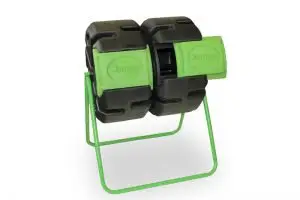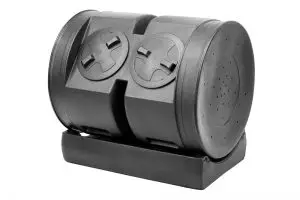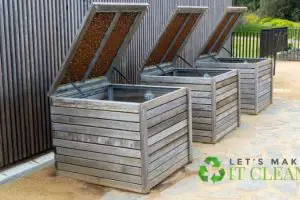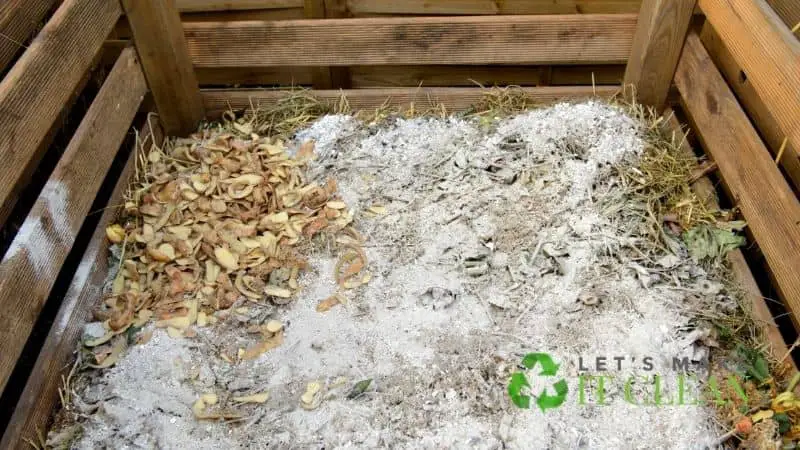Does a compost aerator work? Yes, it does. You only need to ensure that you have the right tool for the job that is also comfortable for you to use.

Here is the ultimate guide on how to use the compost turners.
What Is a Compost Aerator?
A compost aerator is a garden tool; that comes in handy in helping you turn the compost in the compost pile or compost bin.
Quick Navigation
- What Is a Compost Aerator?
- How Often Should I Aerate My Compost Pile?
- Do You Need to Cover the Compost Pile?
- How Long Until the Compost Is Usable?
- Compost Aerating Tools. Does a Compost Aerator Work?
- What Should You Consider When Buying an Aerator?
- Reasons for Using Compost Aerators
- How Do Compost Aerators Work Better Than Other Composting Tools?
- Conclusion
For effective decomposition to happen, the compost requires proper aeration, temperature, and moisture. The microorganisms involved in the composting process use up the available oxygen fast.
As such, there is a need to aerate the compost to prevent anaerobic bacteria from taking over. Turning the compost also speeds up the decomposition process by getting the compost materials to the center of the pile, where the temperatures are high.
But how do you turn the compost effectively, and can you use any tool? Do compost aerators work?
How Often Should I Aerate My Compost Pile?
For effective composting to happen, the aerobic microorganisms require air. When you start the composting process, the microorganisms use up the available air.
You need to aerate the compost pile to keep the activities of the aerobic bacteria active.
As composting continues, compaction of the compost material happens, which gets rid of the air pockets.
If you don’t aerate the compost bins, anaerobic bacteria take over, leading to an unpleasant smell.
So, how do you aerate the compost?
You aerate the compost by turning the pile often. Air wouldn’t get to the bottom of the pile without turning it.
For effective turning of the compost pile, you need to make sure you have the right tools for the job. Although you can use a shovel, using a compost aerator, also known as a compost turner, would be the best option.
Compost aerators are easy to use on the compost heap. The pointed end of the compost aerator plunges into the compost heap to create large pockets of air inside the heap.
The pulling and pushing help to redistribute the material in the compost.
Do You Need to Cover the Compost Pile?
There is an unending debate on whether you should cover the compost pile or not. There are strong opinions among composters on why you should cover the compost and why you shouldn’t.
However, the decision to cover or not to cover depends on your composting goals, your choice of composting system, and where you live.
If you are using a manufactured compost bin and it comes with a lid, you should use it. The system probably requires the lid for it to function properly. Otherwise, you have to decide whether you need a cover or not.
Ordinarily, you don’t need a cover for computing to take place. For effective decomposition to happen, you need a balance between nitrogen-rich and carbon-rich materials. You also require moisture and proper aeration.
If you don’t have one of these, you can slow down the composting process, or your compost will become smelly. As such, having a cover can disrupt the composting process by limiting airflow and moisture.
However, you should make sure you cover the finished compost. If you don’t, the air and moisture will make the compost break down further, leading to loss of nutrients.
How Long Until the Compost Is Usable?

How often you turn the compost determines the composting speed. The more times you turn, the more the aeration which speeds up the process. Turning the composter materials also ensures you get more material to the center of the pile where the temperatures are high.
Hot composting also yields faster results than cold composting.
Depending on these factors, your compost will be ready for use in four weeks to twelve months. Using a tumbler can give you finished compost in three weeks to three months.
Compost Aerating Tools. Does a Compost Aerator Work?
Turning a large pile by hand can be daunting. Thus, you need a composting tool to help you with the work.
Compost aerators do work. If you are going for the manufactured options, they come ready to use. For instance, many of them come with padded handles to ensure that you are comfortable as you work.
On the other hand, you have a contraption that comes with wings to ensure the aerator works well.
The idea is to have a tool to plunge in and out of the compost for aeration purposes.
There are two types of compost aerators, which include:
1. Plunger
Plungers have a pointed pole and two folding tines. The tines close as the aerator goes into the compost and open when it is pulled out.
2. Corkscrew
To use the corkscrew, you should twist the tool into the compost and then pull it out. It is ideal for light composts as the twisting can twist muscles.
What Should You Consider When Buying an Aerator?
The price point is an important factor to consider. Ensure that the aerator is within your budget. You should also consider the material and durability. For instance, an aerator with nylon handles is durable and also comfortable to use.
Before you can settle on a particular tool, it’s good that you check its reviews online to see what other users say about it. It will also help if you read different buying and user guides to ensure it is the right tool for the job.
Versatility is also key. You can go for a turning tool that can also come in handy for other purposes. For instance, you can use a hand cultivator that also helps you in compost turning.
Reasons for Using Compost Aerators
A compost aerator helps to reheat the pile. You get materials to the center of the pile, where the temperatures can rise to 120 degrees Fahrenheit.
It also helps to create pathways for moisture that combines with air to speed up the decomposing process.
They also help to eliminate odor by ensuring the pile is well aerated.
How Do Compost Aerators Work Better Than Other Composting Tools?
The handles of the aerator will help you to work without much strain. This is unlike a hand fork that can strain the shoulders.
They are easy to use, clean, and maintain without the accumulation of odors.
The tools work without splashing the liquid compost or making your hands dirty.
Conclusion
Having a compost turning tool is something you should consider having, whether you use a bin system or compost pile.
It helps you ensure the pile is well aerated, and you also maintain a balance between the air and moisture mixture.













